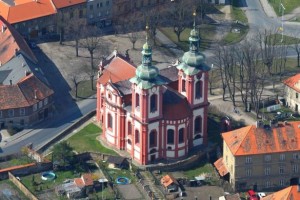
Antonín Dvořák lived in Zlonice, a small town in Bohemia, from 1853 to 1856. He must have been fond of this church’s bells.
I have an odd advantage over Dvořák. I’ve heard this symphony, while he never did. It was composed in 1865, when Dvořák was only 24. He submitted the manuscript to a competition in Germany, and the only copy disappeared, so he never had a chance to hear it performed, or even to revise it. He dismissed it as lost, and did not number it among his compositions. However, in 1882, it was found by a German student in a second-hand shop in Leipzig, and kicked around until it finally resurfaced in 1923. It did not have a complete and unaltered performance until 1973.
How does it sound? It’s pretty much Mendelssohn, or rather Mendelssohn when he sounds most like Beethoven. But it’s damn good for a callow youth’s first symphony, and could stand on its own at any concert. Every now and then you hear a premonition of distinctively Dvořákian features. Many passages are beautiful, or at least entertaining. It just doesn’t come together in a completely satisfying way. The recording I have is conducted by Stephen Gunzenhauser, with the Czecho-Slovak Radio Symphony Orchestra, and was made in 1993 (only 27 days after the separation of the Czech and Slovak Republics, hence the oddly hyphenated name). It isn’t clear why it was called “The Bells of Zlonice” ― there are no bells in it, or bell-like passages, and the phrase is nowhere on the score ― but Dvořák is reputed to have called it by that name in later years. He lived in the small town of Zlonice for three years, and it has rather nice looking church. Perhaps its bells were particularly fine. How much of this youthful work did he remember? Could he play parts of it in his head, in old age, or did it simply disolve into a vague impression? Sadly, we get to indulge in the guilty pleasure of listening to some perfectly good Dvořák that Dvořák himself never heard. So let us at least hoist a pilsner to his honour, whenever we do so.
0 Comments.